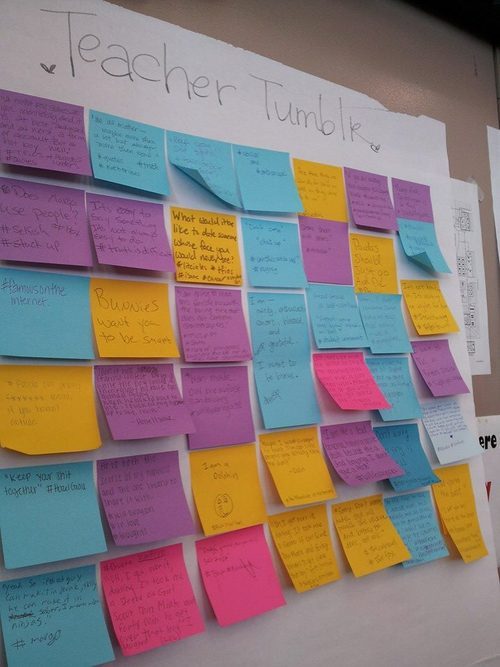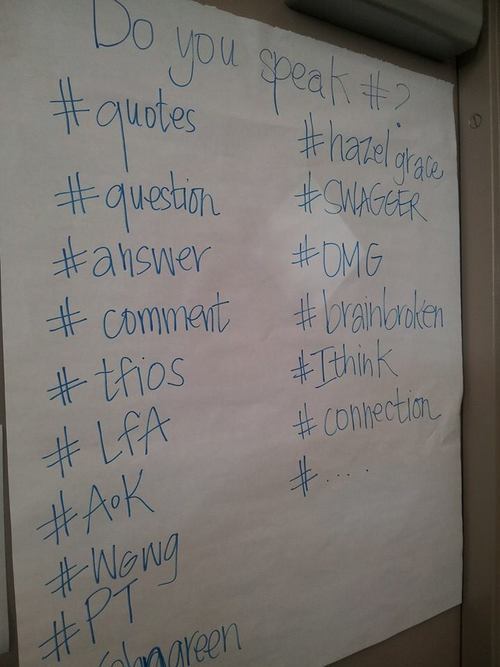

 I absolutely LOVE this activity. I have tried similar strategies, but this teacher describes in detail the process and outcome - I love it!
I absolutely LOVE this activity. I have tried similar strategies, but this teacher describes in detail the process and outcome - I love it!
In this class, students read the John Green novel of their choice. We didn’t attempt to balance the groups. Because it was enrichment, we really wanted students to have choice and to read the novels that spoke to them. We had about 35 students read The Fault in Our Stars. We had just 6 students readWill Grayson, Will Grayson. The rest of the students were scattered about equally between Paper Towns, Looking for Alaska, and An Abundance of Katherines.
Our Goals
1) Students read independently. 2) Students come prepared to engage in text-based discussions. 3) Students write analytically about the text.
The strategy we introduced on the first day was a way of cataloging their Post-It notes during their reading. We knew students would find a great number of passages in their reading that they found meaningful, but I wanted to push them to think more about why they passages they marked were significant. (In previous Breakfast Club sessions, we’d found students didn’t want to annotate IN THEIR BOOKS. For many of our kids, this was the first new book they’d ever owned and they were reluctant to write in them!)
Our students loved to highlight their favorite passages by copying them onto Post-Its. We asked them to tag those significant passages #quotes. We also asked them to consider other hashtags, like #characterization, #plot, and #figlang. Students were also encouraged to write their questions and reactions on Post-Its and to tag them accordingly. From the first week, students were excited.
Every student had a large piece of construction paper where they were able to arrange their Post-Its each week. We used them for first check ins. Students would read the “Tumblrs” of their group mates. We encouraged them to “like” and “comment” on each other’s Post-Its. They were also able to “reblog” other student’s thoughts if they wanted to add to them. (We made sure they gave their classmates credit.) We also had a “Teacher Tumblr”. We used this to keep track of comments we heard when listening to the group discussions and questions that came up for us. We also invited students to add questions and comments, which they did. With enthusiasm.
Integrating Evidence Meaningfully in Discussion and Writing
One way we used the Post-It Notes to help students get ready to speak and write about their texts was to ask them to pull out those Post-Its on which they’d written significant lines or passages from the text. We knew our students could read and opine about the action and the characters, but they struggled to present substantial evidence to support their assertions. Their first instincts were not to begin with the text and work out from there. Often we’d receive writing assignments that included NO evidence from the text. In revision, students would go back to the text looking for three or four quotes to shove into the already-written essay. Not a lot of commentary there.
So we asked students to pull out those quotes, and then on new Post-Its, we asked them to write a sentence or two of context. What’s happening in the quote or passage? What would a reader need to know? #context Now, get another Post-It. What does it mean? What is the writer doing? Why is it significant to the greater meaning of the text? #commentary
Students began to understand the ways they could be commenting on the text, and they began making these notes independently as they were reading.
It was powerful because when we asked students to come together and discuss questions about their text, they were ready to talk. They had things to say. They went to their Post-It Notes and some of the processing had already begun.
The flexibility and mobility of the Post-Its also helped our students to track the development of characters and themes across the text. They could group patterns together, they could look at statements characters made early in the text side by side with statements they’d made later in the text.
We introduced “The Author Says, I Say” to help students see how to seamlessly integrate evidence into their own writing.
On the last day, when we gave the students an unannounced on-demand writing assignment, you could hear a pin drop in the room. Students who used to struggle to write a sentence had something to say. In all the weeks leading up to the last class, we never told the students they would be expected to write, but when we asked them to, they were ready, because they had already had multiple opportunities to process their thinking, and discuss and write about the text.
Our students reported feeling more confident as readers and writers and during the debrief, they talked about ways they could use the strategies in other classes.
Source

No comments:
Post a Comment